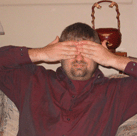Really who am I kidding? the Critical Path part of this project disappears next to the Rube Goldberg part of it. So here we are at the 2012 Basic PTM Rube Goldberg Project.
 |
| From BPTM2012Rube |
This year the class was smaller, so instead of five groups we had four. Because of that I increased the number of events per person per group to 5 from 4. I also did away with the required parallel path in the full class machine. Mostly that last bit was because the old way was just a lot less interesting to watch.
I started out the day of this time talking about what I was hoping people get out of the experience. Every year I debate doing this project on the grounds that it really doesn't help them learn anything about critical path. They do a CPM analysis of their machine, but the evaluation there isn't very complex since at most there are two parallel paths at any time. It is a fairly graphic representation of how if one task falls apart the whole project stops, but in the end I think that's fairly intuitive.
So what do they get? Well, to start with, the thing has a fairly epic, immovable due date that requires everyone to be done at once. That's not typical of the projects they've done to date in other classes and I think is fairly representative of a theatrical collaboration. They get experience working with a group. They've done group work already, but the interconnectedness of this project ups the thing to a new level I think. Then also there's the dimension of the groups having to work together which is something they haven't already had, and again I think represents theatre work pretty well.
One of the original reasons for giving this project is that it absolutely defies being done in one last minute all-nighter. If they don't plan ahead and work on it over time there is just no way it can possibly be successful. I feel like this is a big lesson, and since the first year I have always presented the project by saying "this cannot possibly be successfully achieved at the last minute." Even with that admonishment they usually do wind up with an all-nighter at the end. I think this year's group had their first successful run at 8:30am. I must admit I still do think it's fun coming in to the room for class and seeing this:
 |
| From BPTM2012Rube |
So, planning ahead, working in groups, working in groups of groups, working to a hard deadline - all useful management behaviors to master, and maybe just a smidge of critical path as well. Of course you can add on top of that all kinds of engineering learning: more planning, materials, tolerances, repeatability, "clean and workmanlike manner," reset time... and I guess there are even some design issues being drilled here with respect to composition if nothing else.
This year's group had an unsuccessful first run and had to make some modifications before the second trial and in the break one of the other instructors said "there is so much learning happening right now." I guess maybe I should stop questioning whether it is a worthwhile use of our time.
Without further delay, here are the students explaining what should happen:
and then here is a fixed position video of their successful run:
and finally here is a "tracking shot" from one of the cameras you see in the last video:
Last but not least here are some still photos from the event:
All in all a successful day of school.
After getting the videos online this time around I went back and watched the video from each of the prior years - this is the fifth time around. It's a pretty neat body of work. I'm glad I've been recording over the years. If you are interested, the other videos are all someplace here on the blog or mostly accessible through my YouTube.


1 comment:
they have such comfy looking chairs!
Post a Comment